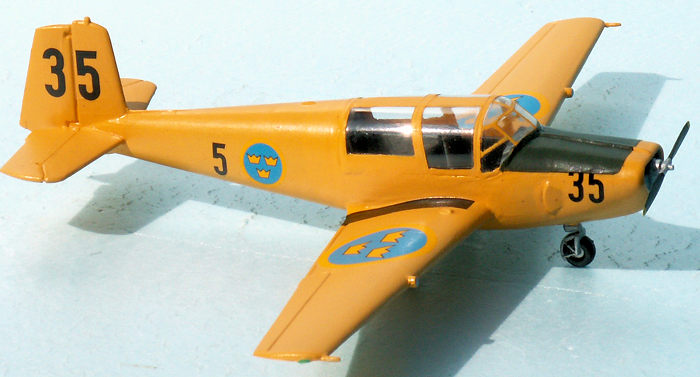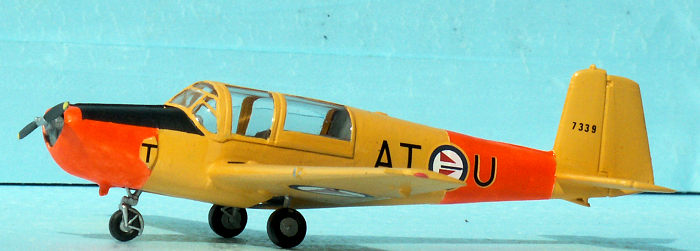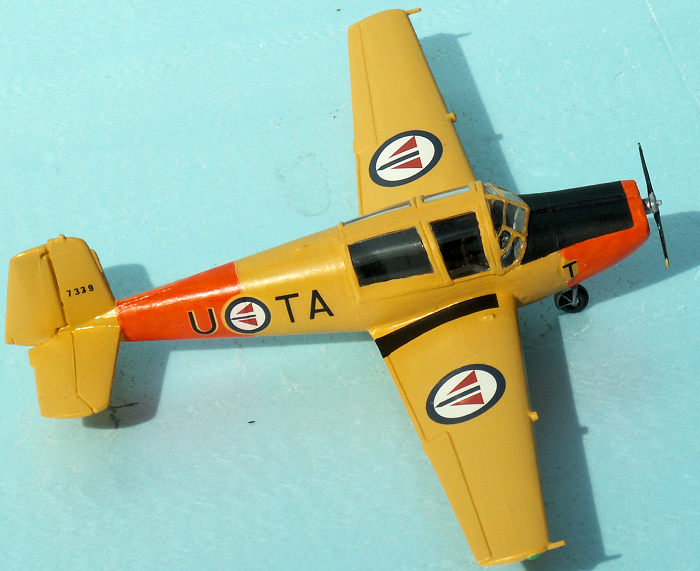
Heller 1/72 SAAB 91 Safir
| KIT #: | 80262 |
| PRICE: | $13.00 |
| DECALS: | Two options |
| REVIEWER: | Torben Plesberg |
| NOTES: | Swedish SK 50 B and Norwegian SAAB 91 B-2 |

| HISTORY |
The SAAB 91 flew for the first time November 20 1945. It was designed by Anders J Andersson, who also was responsible for the German Bücker Bü 181 Bestmann, the elementary trainer of Flygvapnet, which was replaced by the Safir (Sapphire), the popular name of SAAB 91.The Bestmann was a low wing two seat side by side monoplane of wooden construction with a tail wheel landing gear. The Safir was a low wing three or four seat monoplane of metal construction, and with a tricycle landing gear.
 Since
the SAAB plant was busy building the J 29 Tunnan fighter plane for Flygvapnet,
the production of the Safir went to De Schelde in the Netherlands. Flygvapnet
ordered totally 100 planes: 76 Sk 50 B with three seats, 14 Sk 50 C with four
seats, and 10 SAAB 91 A. The latter was powered by a De Havilland Gipsy Major
four cylinder in line engine, The Sk 50 B and C were powered by Lycoming 4
cylinder boxer engines. Svenska Flygmotor AB had developed a four cylinder boxer
engine for the Safir called “Trollet”, however this engine was used for army
vehicles.
Since
the SAAB plant was busy building the J 29 Tunnan fighter plane for Flygvapnet,
the production of the Safir went to De Schelde in the Netherlands. Flygvapnet
ordered totally 100 planes: 76 Sk 50 B with three seats, 14 Sk 50 C with four
seats, and 10 SAAB 91 A. The latter was powered by a De Havilland Gipsy Major
four cylinder in line engine, The Sk 50 B and C were powered by Lycoming 4
cylinder boxer engines. Svenska Flygmotor AB had developed a four cylinder boxer
engine for the Safir called “Trollet”, however this engine was used for army
vehicles.
The Sk 50 B and C were delivered to F 5, Krigsflygskolan, for elementary school flying. The SAAB 91 A was delivered to other wings of Flygvapnet as a transport plane under the designation Tp 91.
The Safir served from 1952 to 1970 with Krigsflygskolan, when the successor to the Safir, the Scottish Aviation Bulldog Sk 61 was introduced at F 5. The Safirs were gradually transferred to other wings of Flygvapnet, serving as general trainer, weather reconnaissance and liaison planes. By 1992, the last Safirs were sold on the civil market, and civil flying clubs were initiated at several Flygvapnet wings with the purpose of offering non-flying staff members a chance of attaining a private license for fun flying.
 My first
sight of a Safir was in 1962 at an airshow in Malmö, Bulltofta Airport.
Actually, there were two Safirs from F 5 present, and they performed “balloon
hunting”- destroying balloons with the propeller. The poor balloons never had a
chance to get away! The 50039 had a special 1962 airshow color scheme with black
“tiger” stripes on the rear of the fuselage. The 50035 was just an ordinary
plane from F 5 – Krigsflygskolan. The “35” is the subject of one of my models.
My first
sight of a Safir was in 1962 at an airshow in Malmö, Bulltofta Airport.
Actually, there were two Safirs from F 5 present, and they performed “balloon
hunting”- destroying balloons with the propeller. The poor balloons never had a
chance to get away! The 50039 had a special 1962 airshow color scheme with black
“tiger” stripes on the rear of the fuselage. The 50035 was just an ordinary
plane from F 5 – Krigsflygskolan. The “35” is the subject of one of my models.
The second model is of a Norwegian Safir, almost as it appeared at an open day air show at Skrydstrup Air Base in 2016, however with a small civil Norwegian registration on the fin. The aircraft belonged to Sola Flystation Flyklubb – The flying club of Sola Air Force Base. Apparently, the Norwegians got the same idea as their Swedish colleagues about non-flying staff members possibilities of getting airborne.
| THE KIT |
 The kit
comes in a plastic bag with a cardboard closure. On the front of the closure,
there is a picture of a Swedish Sk 50 from F 10. The instructions is a single
folded A 4 sheet. On the front side, there is a very short history of the Safir,
and seven steps with exploded sketches, showing how to put the 25 parts
together. On the rear side, there are two four-plane drawings showing the color
schemes and decaling of the two options of the decal sheet: a Norwegian and a
Swedish aircraft. Besides, there is a color guide with Humbrol reference
numbers. There are three sprues in a light grey styrene, and a clear sprue with
the very large canopy. The parts are with a few fine raised panel lines. Not all
parts fit well together. The kit is the three- seat version, with a gasoline
tank in the cabin, in the port side to the rear.
The kit
comes in a plastic bag with a cardboard closure. On the front of the closure,
there is a picture of a Swedish Sk 50 from F 10. The instructions is a single
folded A 4 sheet. On the front side, there is a very short history of the Safir,
and seven steps with exploded sketches, showing how to put the 25 parts
together. On the rear side, there are two four-plane drawings showing the color
schemes and decaling of the two options of the decal sheet: a Norwegian and a
Swedish aircraft. Besides, there is a color guide with Humbrol reference
numbers. There are three sprues in a light grey styrene, and a clear sprue with
the very large canopy. The parts are with a few fine raised panel lines. Not all
parts fit well together. The kit is the three- seat version, with a gasoline
tank in the cabin, in the port side to the rear.
| CONSTRUCTION |
 If you
follow the instructions, you will end up with a nice small model of a SAAB Safir.
There are, however, some steps needing some attention:
If you
follow the instructions, you will end up with a nice small model of a SAAB Safir.
There are, however, some steps needing some attention:
Step 5: The fin and rudder should be angled about 2 degrees to the left – to compensate for the torque of the engine. The angle is, however, more than 5 degrees, and needs correction by forcing the fin and rudder to the right. The model needs a lot of weight in the nose to avoid tail sitting. There is sufficient room for lead between the nose gear and the cowling front.
Step 6: The starboard tail plane must be lowered about 0.75 mm to get in alignment with the port tail plane. Be careful, to get the wing perpendicular to the fuselage. There is nothing to guarantee a perfect position of the wing!
Step 7: The holes for the main landing gear must be drilled properly, before the legs can be glues in place. The canopy is rather crude. Maestro Models offer a Vacform canopy for the Heller 1/72 Safir. I bought a set with two canopies, and I put one of these on the Swedish model, and put the Heller canopy on the Norwegian model – just to compare the difference of the look. Without any doubt, the Vacform canopy is superior in quality! Besides, it is easier to paint the frames properly on the Vacform canopy.
| COLORS & MARKINGS |
A Safir of the Royal Norwegian Air Force is trainer yellow all
over, HB 24. It has a broad day-glow band on the rear fuselage and on the
cowling. Four layers of Testor Reefer White 4873, and four layers of Testor
Fluorescent Red 4703. The wing tips have a small day glow band, too The anti-
glare area in front of the wind screen is matt black, Testor Engine Black 4888,
likewise the propeller blades with yellow tips and the tires. The landing gear
is Alumin um, Revell Aqua 99. The decals are from the kit, well printed in
register, and easy to apply. The decaled model got finally a layer of HB Satin
Cote to protect the decals and provide a nice finish.
um, Revell Aqua 99. The decals are from the kit, well printed in
register, and easy to apply. The decaled model got finally a layer of HB Satin
Cote to protect the decals and provide a nice finish.
The Swedish Safir is also trainer yellow all over. The anti- glare area, however, is Olive green, Revell Aqua NATO Olive 46. The colors of the details are just like the Norwegian plane. The Decals were not from the kit: The national insignia are from a Flying Color sheet. The numbers 5 and 35 are from different Swedish kits from my stock. The problem was to find the 35 in two different sizes and the right type of numbers. I succeeded in making a model of one of the first Safirs I ever saw.
| CONCLUSIONS |
The Heller 1/72 SAAB Safir is a nice little kit with some minor flaws. These will cause a beginner trouble. The experienced modeler can do a nice and authentic model of this classic Heller kit, especially if the Vacform canopy of Maestro Models is applied. The kit is recommendable for experienced modelers, not for beginners.
| REFERENCES |
Wikipedia article in Swedish: SAAB 91 Safir.
My photos of Sk-50B and C
16 December 2019
Copyright ModelingMadness.com
If you would like your product reviewed fairly and fairly quickly, please contact the editor or see other details in the Note to Contributors.
Back to the Main Page Back to the Review Index Page Back to the Previews Index Page